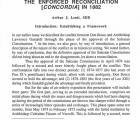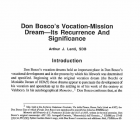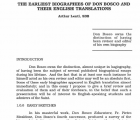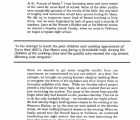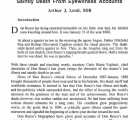
Introduction
Part I: Chronicles and Memoirs
I-Carlo Maria Viglietti: His Chronicles and Memoirs
(1)Viglietti, Don Bosco’s Secretary
(2)Viglietti’s Chronicles and Memoirs
[i] Original Chronicle
[ii] Transcribed and Edited Chronicle 1884-1888
[iii] Short Autobiographical Memoir
[iv] Diary
[v] Additional Chronicle 1884-85
[vi] Scrapbook-Style Collection 1886-1896
[vii] Partial Calligraphic Chronicle 1884-1885
II-Pietro Giuseppe Enria and His Memoirs
(1)Enria, Don Bosco’s Sick-Room Attendant
(2)Enria’s Memoir
III-Antonio Sala and His Memoir
(1)A Word about the Man
(2)Sala’s Memoir
IV-Francesco Cerruti and His Memoir
V-Father Michael Rua’s Reports
VI-Dr. Giovanni Albertotti and His Biography of Don Bosco
Part II: Don Bosco’s Bouts with Illness and the Years of His Decline
I-Antecedent Medical History
II-The Crises of 1884
(1)February 1884
(2)Journey to France and Dr. P.-M Combal’s Diagnosis
(3)September 1884
III-The Period of Quasi-Retirement and Decline (1885-1887)
(1)The Trip to Southern France in Early 1885
(2)Summer and Autumn of 1885
(3)Don Bosco’s trip to Spain (Barcelona) in Early 1886
[i] Passing through Southern France
[ii] Barcelona
(4)Back in Turin in the Latter Half of 1886
(5)Don Bosco in Early 1887
(6)The Last Journey—to Rome
(7)Summer and Autumn of 1887
(8)Foreboding of the End: December 1-20, 1887
Part III: Don Bosco’s Last Illness and Saintly Death
Introductory Comment of the Nature of Don Bosco’s Last Illness
I-The First Crisis: December 20-31, 1887
II-Period of Illusory Recovery: January 1-20, 1888
III-The Final Crisis and Don Bosco’s Saintly Death: January 21-31, 1888
(1)Sudden and Inexorable Relapse: January 21-28, 1888
(2)Hope No More: January 29, 1888
Conclusion

